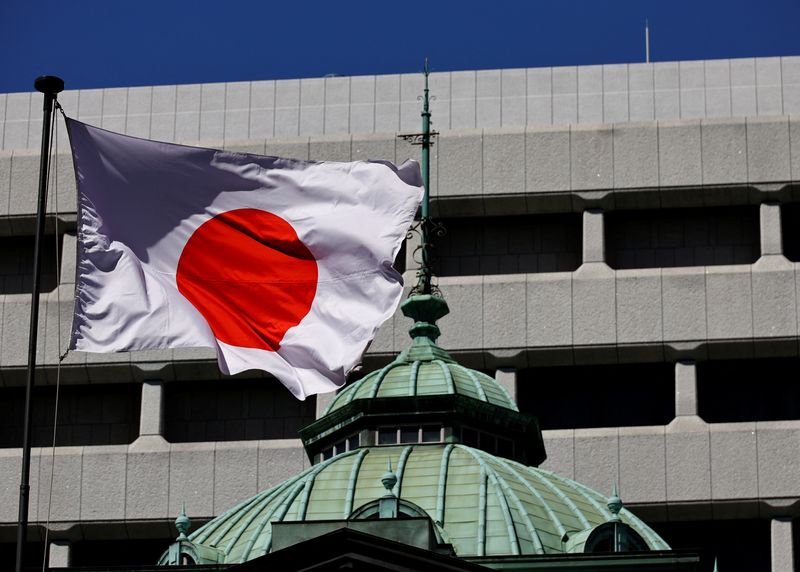By Junko Fujita and Tom Westbrook
TOKYO/SINGAPORE (Reuters) – Japan’s $9 trillion bond market is bracing for disruption as a shortage of paper caused by the central bank’s massive buying is expected to hit the settlement of derivatives used by investors and the dealers who underwrite the nation’s debt sales.
Decades of fighting deflation drove the Bank of Japan (BOJ) into asset purchases and made it the majority owner of the country’s national debt, with a balance sheet bigger than the $4 trillion economy and five times the size of the U.S. Federal Reserve’s, relative to gross domestic product.
That has kept yields down and made the Japanese market unattractive to investors, leaving its bonds illiquid and unreliable as a benchmark for interest rates.
Now as the BOJ pares back its balance sheet towards a normalisation of markets, the long-awaited revival of trading in the debt pool is proving a slow and bumpy process.
A test looms in the futures market from December when 10-year contracts will be linked to the government bond #366 tranche that is 95% owned by the BOJ.
Participants say the bond’s scarcity in the open market will interfere with buying the so-called ‘cheapest-to-deliver’ bonds to settle derivatives contracts at maturity, crucial for the market to trade smoothly and price with precision.
“The lack of the cheapest-to-deliver bonds makes it hard for investors to hedge risks for rising rates,” said Keisuke Tsuruta, senior fixed income strategist at Mitsubishi UFJ Morgan Stanley Securities. “This makes overall trading difficult.”
Tsuruta said this will affect not just trade and speculation but also government bond auctions, since primary dealers who bid at these auctions mostly use futures to offset their exposure.
With the BOJ having embarked on a rate hike path, investors are also seeking the cheapest bonds to settle short positions in futures, and distortions in the derivatives market would hurt them.
A shortage of such bonds will imply “hedging with futures is not functioning,” said Masayuki Koguchi, executive chief fund manager at Mitsubishi UFJ Asset Management.
DYSFUNCTIONING DERIVATIVES
Japanese government bond (JGB) futures are listed on the Osaka Stock Exchange. Benchmark 10-year futures, which are contracts that run for three months, are used to speculate on where yields will be in the future and are linked to an underlying cash bond.
They are the deepest part of the market and vital for participants, from hedge funds to corporations, who want to bet on interest rate movements or use the market to offset an exposure.
Unlike with stock futures, sellers of JGB futures have to physically deliver bonds at the end of a contract, rather than merely settle the difference in prices.
The rules allow sellers to deliver bonds with between seven and 11 years to maturity against 10-year JGB futures, and under the conversion factor the exchange uses, government bond #366 will become the cheapest-to-deliver in late December, for contracts that mature in March.
That tranche was the 10-year benchmark in 2022 when Japan’s central bank was buying billions in bonds to defend a 0.25% yield cap against speculative short sellers.
The result is that BOJ owns more than 95% of #366, which will leave futures sellers scrambling to get hold of it or go for more expensive bonds to settle their deals.
The situation is reminiscent of the distortion in JGB futures in June 2022, when a surprise BOJ intervention at the cheapest-to-deliver tenor caught dealers off guard. Futures collapsed along with bidding at JGB auctions, which turned in some of the poorest auction results in more than 30 years.
Then, the BOJ relaxed rules to make it easier to borrow bonds and, to be sure, a similar move – or if the finance ministry reopened the tranche to sell more debt – would reduce pressure on the market. But that, too, would highlight its fragility.
“This situation reflects the adverse effect of the BOJ’s easy monetary policy,” said Miki Den, a senior Japan rate strategist at SMBC Nikko Securities.
It is also likely to persist next year as subsequent tranches are also heavily owned by the BOJ. A bearish outlook for bonds is keeping large JGB traders out of the cash market too, making it likely normalcy will come to Japan’s debt markets only over an extended time-frame.
“They’re basically trying to unwind, let’s call it the last decade, decade and a half or so of policy,” said Norman Villamin, chief strategist at Union Bancaire Privée.
“When you put it in the context of these decade-plus types of time horizons … normalisation which has been under way for about two years (is) not particularly out of kilter with those timelines.”
(Reporting by Junko Fujita and Tom Westbrook; Editing by Vidya Ranganathan and Muralikumar Anantharaman)
Read the full article here

